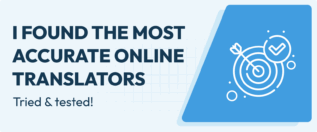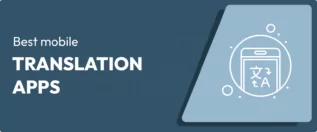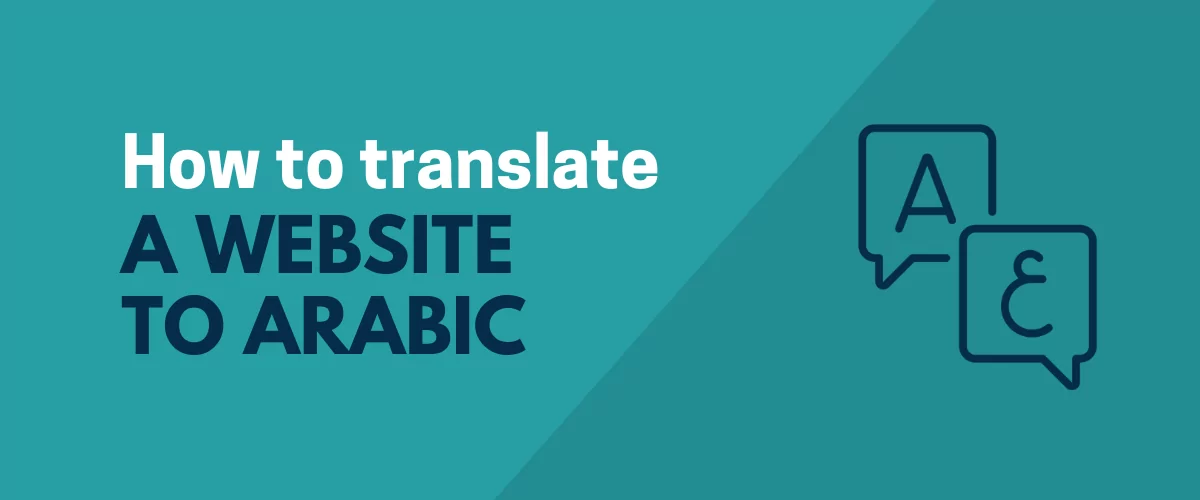
In this post
Can’t figure out how to translate a site to Arabic? Well, you are not alone.
Translating a website to Arabic and vice versa is a challenge even for the best of translators.
And that’s because English-to-Arabic translations pose unique challenges compared to other language pairs, such as English-to-French.
Let it be known that Arabic is one of the five hardest languages to translate, and we will learn why later in the article.
Still, translating your website to Arabic is a fantastic way to reach a wider audience and grow your brand, among other things.
Now, translating a single page to Arabic is super-duper easy. But we can’t say the same about translating your entire WordPress website.
Translating an entire website might seem impossible for a beginner who doesn’t know any better.
But nothing could be further from the truth, especially if you have a WordPress translation plugin such as TranslatePress.
As we will learn later in the post, the plugin allows you to translate every part of your WordPress website to Arabic, be it text, images, SEO elements, URLs, and content from your themes or plugins.
It is truly a remarkable plugin for your toolkit as a translator or WordPress developer.
The best part is that the base version is 100% free, meaning you can start translating your site to Arabic immediately without spending a dime. And with added features and functionality, you’ll quickly see why the pro version is worth every penny.
With that said, let us dive right in and learn how to translate a site to Arabic quickly and accurately.
Benefits of Translating a Site to Arabic and Vice Versa
Before we discuss the practical tips on translating English to Arabic, let us cover some benefits to determine if it’s worth your time and effort.
So, how do you stand to benefit from translating your site from English to Arabic or vice versa? Well, you will be glad to discover there are several benefits.
Expanded Audience and Global Reach
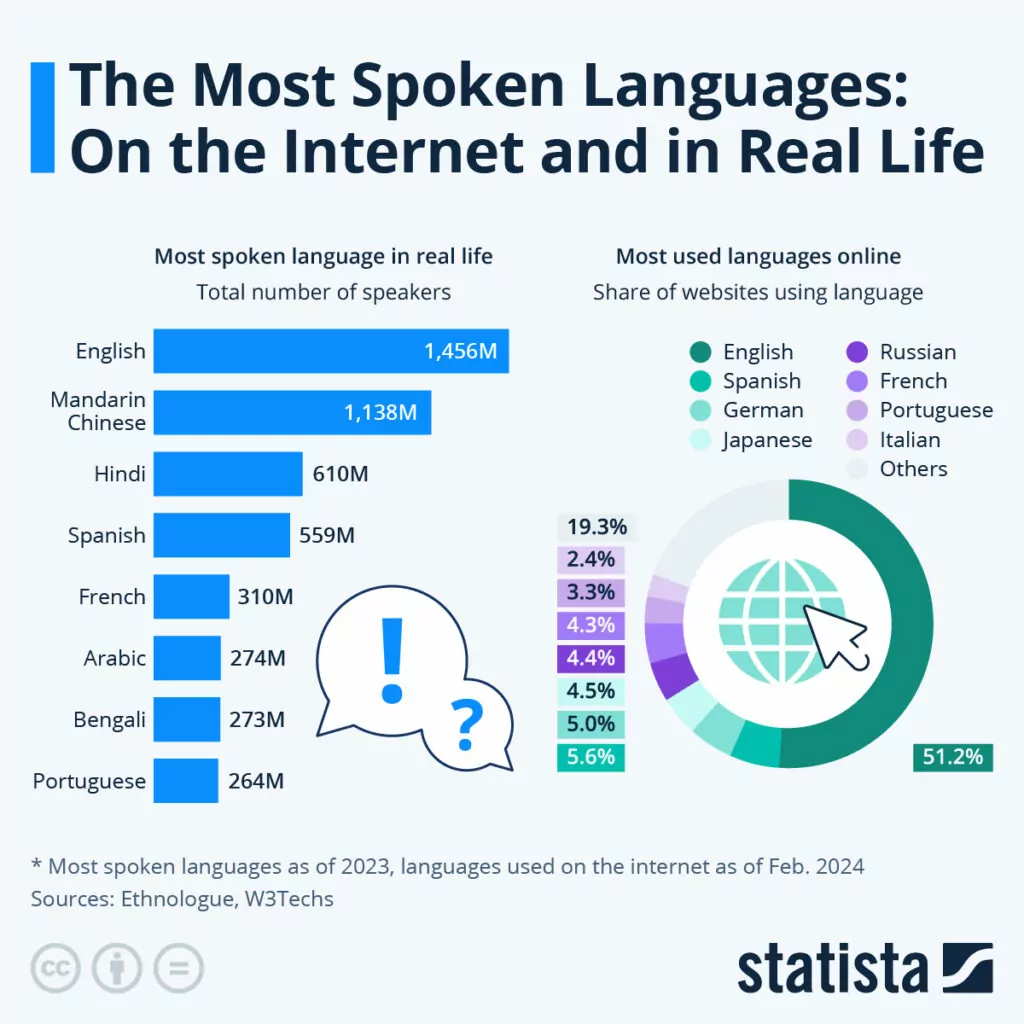
Source: Statista – The Most Spoken Languages: On the Internet and Real Life.
With nearly 1.5 billion speakers, English is still the most spoken language in the world. With 51.2% of websites using English, it is also the most used language online.
According to the above chart, Arabic comes at number six with about 274 million speakers. It’s about 400 million in 2024 according to Wikipedia, which makes it the fifth most spoken language in the world.
From a different report, only 0.6% of websites use Arabic, which is still significant considering there are nearly two billion websites online.
Where am I going with this? It’s simple.
Whether you want to translate a site from English to Arabic or vice versa, you stand to reach a wider global audience. It’s one of the major benefits of translating your website.
And do you know what else?
Shoppers are picky where website language is concerned, and there’s data to back the claim.
That’s right. According to a survey of over 8,700 consumers in 29 countries by CSA Research, 65% of shoppers prefer websites in their language even if it’s poor quality.
Additionally, the same study showed that 76% of consumers prefer products with information in their languages.
That’s not all. 40% of the respondents said they would never buy products from a website in another language.
As you can see, it pays to translate your website to reach Arabic-speaking shoppers. If you want to expand into the Middle East and North Africa or your analytics reports show you’re receiving lots of traffic from Arabic-speaking regions, the time is ripe to translate your website.
Arabic-speaking regions offer you significant opportunities for market expansion and business growth. Translating your site from English to Arabic lets you target and engage prospects in these regions.
Let’s move on.
Enhanced User Experience

Maybe I’m alone here, but have you ever visited a website in a language you didn’t understand? I bet your experience wasn’t pleasant. And you probably hit the back button never to return.
Thank God Chrome comes with a Google Translate prompt nowadays. Other browsers are yet to catch up.
We can all agree that it is infuriating to land on a website with content in a language you don’t understand, especially if you are bent on finding the information you need.
In line with this, offering content in Arabic will improve the user experience for Arabic-speaking visitors to your website.
First, translating your site to Arabic will eliminate language barriers, ensuring Arabic-speaking audiences can understand and use your website without hiccups.
It is a great way for your business to demonstrate a commitment to accessibility and usability, which makes your site welcoming to more people.
Additionally, you have the golden chance to personalize experiences for Arabic users. Considering Arabic comes in three main versions and has over 25 dialects, you can tailor your content to distinct groups and subcultures. This includes translating English-to-Arabic slang.
Secondly, translating English to Arabic allows you to localize your website. You can easily adapt elements such as images, currencies, and date formats to local conventions. Doing so boosts user engagement and creates a sense of belonging among Arabic users.
At the same time, you can deliver your marketing messages in Arabic, which boosts user engagement and conversions.
Thirdly, translating your website to Arabic will reduce bounce rates among Arabic-speaking users. Arabic users will spend more time interacting with your content since it’s in a language they understand.
No matter how you view it, a better user experience leads to higher engagement, longer session durations, and increased conversion rates.
Enhanced SEO and Online Visibility
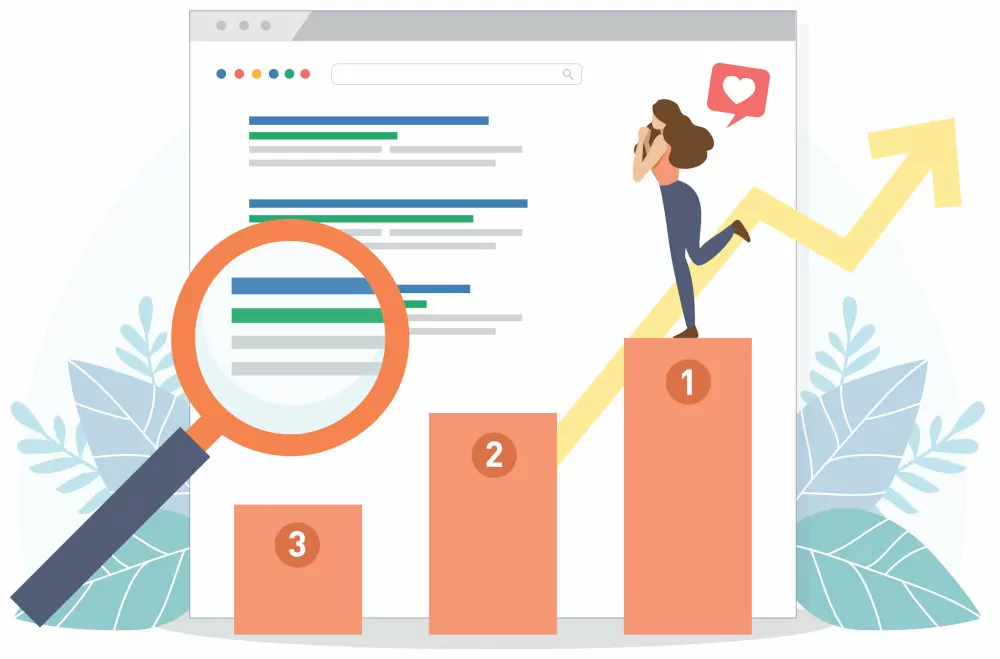
Drawing traffic to a website is one of the hardest tasks every online entrepreneur faces.
Still, traffic is the lifeblood of any website. Without web visitors, your site is a dud. It’s plain simple.
Granted, there are many effective ways to drive traffic to a website. One of the best ways is search engine optimization or SEO in short.
SEO involves fine-tuning your website and content to rank higher in search engines like Google and Bing.
So, how does translating your site from English to Arabic improve your SEO?
Allow me to explain.
Whenever someone is looking for your content or products, they usually enter keywords or phrases in a search engine. Suffice it to say many people prefer to use their native language.
If your content is relevant to the keyword or phrase, the search engine will show your website in the search result pages (SERPs).
If you’ve done your homework, your content will appear first, sending more visitors to your website.
Without an Arabic version of your website, Arabic-speaking users will never find your site in SERPs even if they are looking for the content or products you offer.
This is because they enter Arabic keywords or phrases into the search engine.
Translating your website into Arabic allows you to capture these searches, which can significantly boost your traffic in Arabic-speaking regions.
For instance…
Neil Patel increased search traffic by over 47% after translating his content into 82 languages. Need another example? The web hosting company Kinsta noticed an 18% increase in organic traffic after translating their website into 10 languages.
This is what multilingual SEO is all about.
Additionally, you can use geo-targeted content optimization to tailor your content to specific cultural contexts and different Arabic-speaking regions.
This helps search engines understand the relevance of your content to local users, which results in higher rankings for Arabic searches.
Another thing. Creating an Arabic version of your website can help you increase domain authority and trust. Couple that with backlinks from local Arabic websites and you have a winning formula.
And since Arabic users who land on your website will understand the content, they stay longer resulting in lower bounce rates, more engagement, and consequently higher rankings.
After all, you have nothing to lose and your work is minimal. You already have the English content. You only need to translate it into Arabic to enjoy more organic traffic.
Enhanced Brand Reputation

Another major advantage of translating your website to Arabic is enhanced brand reputation. Your web visitors will think of your company as being prestigious and forward-thinking.
If an Arabic-speaking user comes to your site but doesn’t understand a thing because it’s in English, they will exit and probably never return. This reflects poorly on your brand image.
On the other hand, translating your site shows Arabic visitors you care about their needs, which earns you credibility points and boosts your brand reputation.
Generally speaking, Arabic-speaking users appreciate culturally relevant content in their native language.
Translating your site to Arabic demonstrates your commitment to inclusivity and a deep respect for their culture and language.
This, in turn, translates to stronger connections with your brand, fostering increased brand loyalty, trust, and more engagement with your content.
On top of that, Arabic translation allows you to adapt your content to local interests and preferences.
Showing that you understand and care about local customs, slang, and cultural nuances leads to acceptance by natives and an enhanced brand reputation.
It’s all about fostering trust…
All in all, speaking to your target audience in their native language i.e., Arabic, fosters a sense of familiarity and trust.
One more thing. It’s important to translate your website to Arabic keenly and professionally. This allows you to avoid cultural misunderstandings and offensive content that could ruin your brand reputation.
In addition, translating your website to Arabic is a fantastic way of differentiating yourself from the competition.
This offers you a competitive advantage since it sets you apart from businesses that don’t provide support for the Arabic language.
As a result, you can capture a bigger market share, engage users who prefer Arabic content, and establish your company as a leader in diversity and inclusivity.
Arabic visitors will come to think of you as a progressive and customer-centric organization, which earns you bonus brand reputation points.
Compliance with Regulations

Another benefit or rather reason you need to translate a site to Arabic is compliance with regulations. You don’t want to rub law agencies up the wrong way. Now do you?
Unknown to many beginners, there are several laws governing translations. All these laws are meant to make content accessible to all people regardless of their linguistic backgrounds and proficiency.
In some regions and industries, the law mandates website owners to provide content in the Arabic language. This is especially true for sectors, such as eCommerce, education, healthcare, and government.
Translate your website to Arabic to avoid repercussions such as heavy fines and penalties.
Related reading: Benefits of Translation: Top 7 Reasons to Translate Your Website
Now that you know translating a site to Arabic has several benefits, let us look at some challenges of translating this rather interesting language.
How to Translate a Site to Arabic: Challenges

Earlier, we said that translating English to Arabic poses some unique challenges compared to other language pairs.
And that’s mainly because English and Arabic are from two entirely different language families.
Arabic is a Semitic language, which is a branch of the Afro-Asiatic language family. On the other hand, English is a West Germanic language in the Indo-European family.
As such, English and Arabic are worlds apart, which presents several challenges during translation.
In the following section, let us cover the challenges to expect if you want to translate a site to Arabic.
Arabic is Broad
Like, quite broad.
Arabic is the official and co-official language in more than 25 countries. It’s categorized into three main versions: Quranic Arabic, Modern Standard Arabic (MSA), and Colloquial Arabic.
- Quranic Arabic – This is the form of Arabic in which the Quran (the Islamic holy book) is written. This is an endangered language that is mainly used in literature in the form of poems, novels, and historical books. It is also known as Classical Arabic;
- Modern Standard Arabic – The standardized form of Arabic used in formal communication, academic settings, official publications, etc. It is generally accepted as the main communicative dialect, and is mainly learned in school as a second language;
- Colloquial Arabic – This is the informal daily version of Arabic. It is used in mainstream films, movies, documentaries, and popular TV shows. It is an umbrella term that includes Egyptian Arabic, Gulf Arabic, Hassaniya Arabic, Iraqi Arabic, Hejazi Arabic, Levantine Arabic, and more.
Under these three versions, you have over 25 different dialects, which makes it one of the most diverse languages in the world.
This many dialects means that an Arabic speaker in Egypt might have trouble understanding an Arabic speaker from Yemen, for instance.
That’s how broad and intricate the Arabic language is.
This, of course, presents a challenge when you want to translate an English site into Arabic. For instance, which dialect and style should you adapt to reach most people?
The secret here is to stick to Modern Standard Arabic. but keep in mind cultural and religious sensitivities in your translations.
Arabic is Complex
Another challenge beginner translators face is the complex nature of the Arabic language. It is a rich language with a complicated structure not available in many other languages, including English.
First, some terms and terminologies in fields such as science and technology don’t exist in Arabic. This presents a challenge when you want to translate English into Arabic.
Finding equivalent terms or phrases could potentially lead to the loss of the original meaning and style of the source text.
Secondly, translators often struggle with capitalization, which is standard practice in English. Why? Arabic does not have capital letters! This can make conveying context to the translated text confusing, especially for beginners.
Thirdly, the Arabic alphabet has 28 letters while the English alphabet has 26. This means that Arabic has letters and sounds that are non-existent in English.
This can make translating elements such as names a nightmare. Trying to create English versions of terms and vice versa often takes away the charm and cultural nuances of the Arabic language.
Diglossia and Writing Format
According to the Merriam-Webster Dictionary, diglossia is “…the use of two varieties of the same language in different social contexts throughout a speech community.”
This is a common feature of the Arabic language thanks to the diverse variety of dialects. On top of that, Arabic has over 12 million words with letters and sounds that don’t exist in other languages.
Couple diglossia with the cursive alphabet style, challenging vocabulary, and complex grammar structures, and you can see how easy it is to pull out your hair when translating English to Arabic and vice versa.
To be on the safe side, it is best to stick to Modern Standard Arabic, but don’t forget religious sensitivities, cultural nuances, and Arabic slang.
Another thing. The right-to-left (RTL) writing format presents a challenge when you are looking to translate a site to Arabic and vice versa.
Considering English is a left-to-right (LTR) language, translating to Arabic means paying close attention to your website design.
This fundamental difference in writing formats affects the layout of text, images, and navigation menus, among other design elements.
However, there is no cause for alarm. The TranslatePress plugin supports RTL languages and features an intuitive visual translation editor that shows how the design changes with each translation.
It looks something like this:
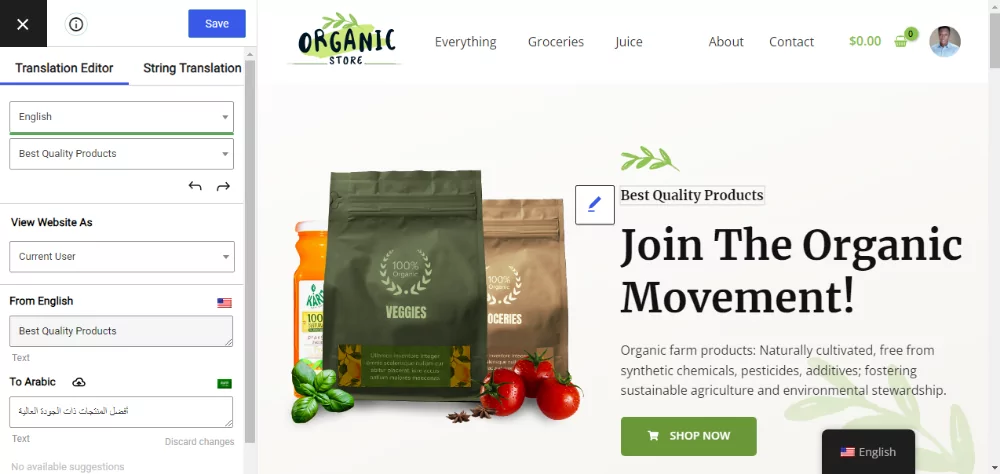
Cultural and Religious Sensitivity
Novice translators often forget that culture influences language, shaping communication styles, idioms, and vocabulary. Arabic is no different.
Arabic-speaking countries have unmistakable beliefs, cultures, customs, traditions, and values that influence language interpretation and use.
The avid translator should be well-versed in these cultural contexts to avoid misinterpretations and literal translations that might be deemed offensive.
In addition, Arabic-speaking regions are largely Islamic – a religion with distinct traditions and values that impact language and societal norms.
To translate a site to Arabic effectively, you should pay close attention to religious terminology, references, and etiquette in your translations.
If you aren’t vigilant enough, you just might shoot yourself in the foot since certain expressions, topics, and imagery are considered offensive or taboo in Arabic-speaking countries.
For effective English-to-Arabic translations, you should exercise discretion and respect cultural and religious sensitivities.
On top of that, endeavor to localize your translations for various regional dialects and ethnicities keeping in mind that Arabic-speaking cultures place great importance on hospitality, respect, and politeness.
Also, ensure your translations are inclusive and don’t display gender bias or any unintended form of discrimination.
This enables you to create respectful translations relevant to your Arabic target audience. It will also demonstrate that you celebrate and respect their culture, which is exactly what you want.
With the challenges aside, let us now dive into how to translate a site to Arabic automatically and manually.
How to Translate a Site to Arabic Using the TranslatePress Plugin
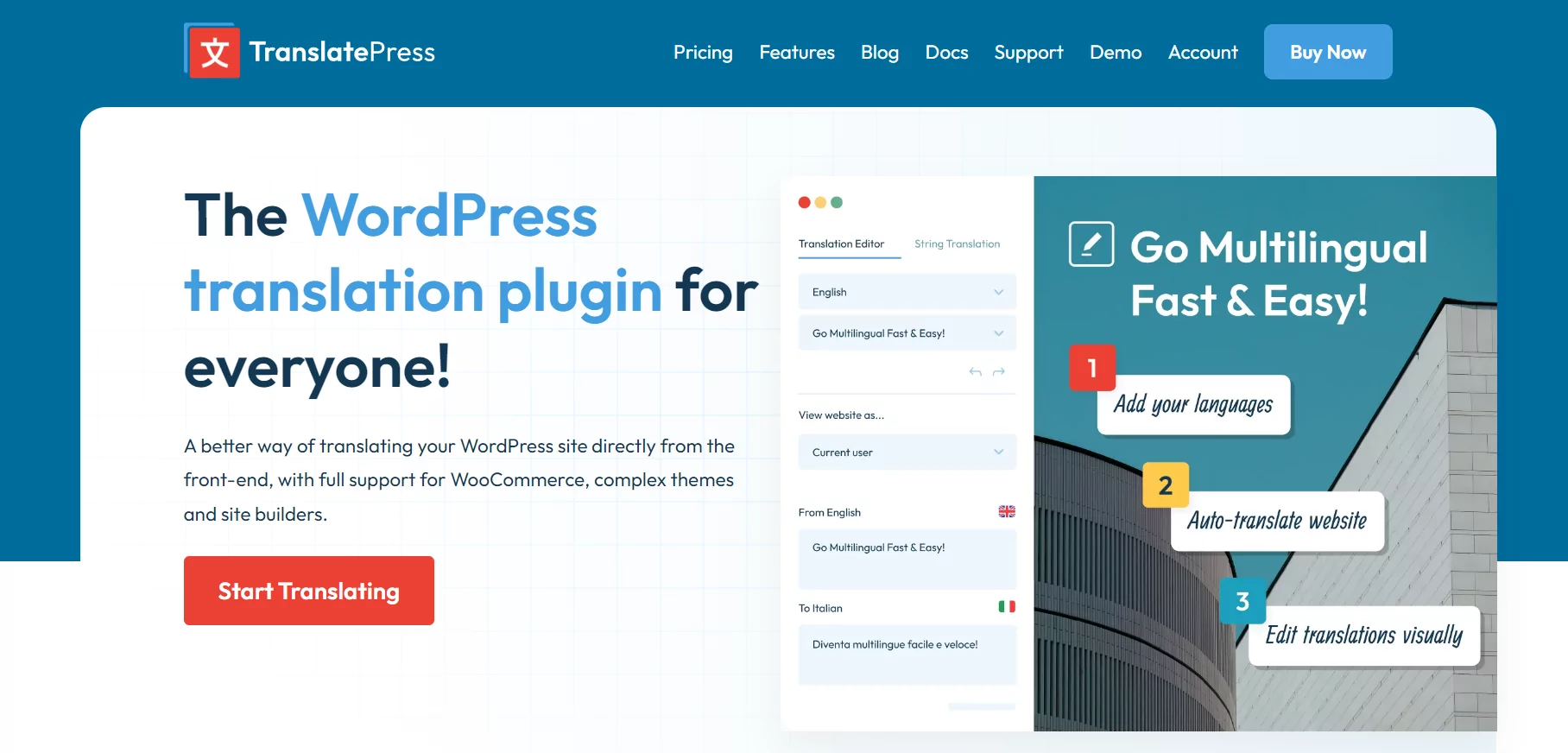
In the following section, we will install and configure the TranslatePress WordPress translation plugin to translate a site to Arabic either automatically or manually.
The process is so easy you should be up and running in a few minutes. Besides, I will hold your hand every step of the way to ensure you don’t stumble 🙂 Also, feel free to ask any pertinent questions in the comment section and we will answer promptly.
Let us begin by installing the TranslatePress plugin.
How to Install TranslatePress
The basic version of TranslatePress is 100% free, meaning you can install it directly inside the WordPress admin dashboard.
Navigate to Plugins → Add New Plugin.
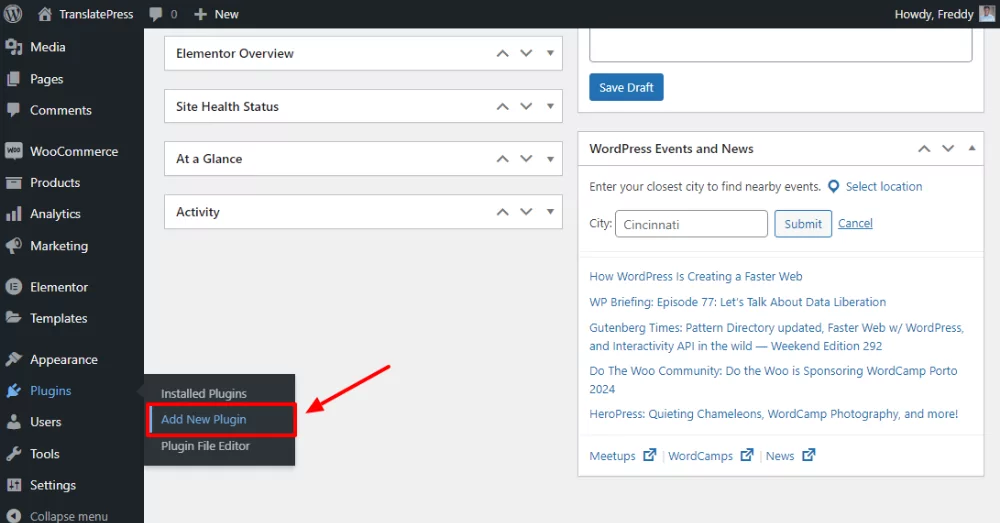
Next, enter “TranslatePress” in the keyword search box and hit the Install Now button, as shown in the image below.
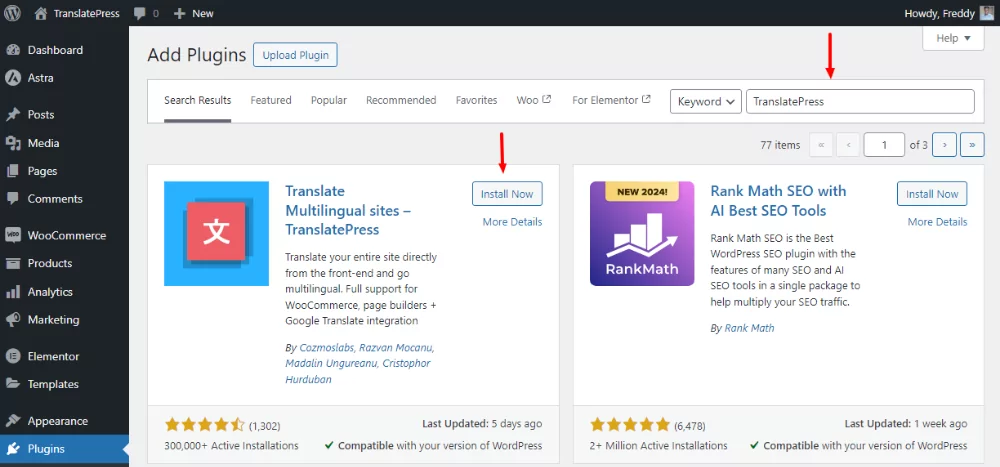
After that, Activate the plugin.
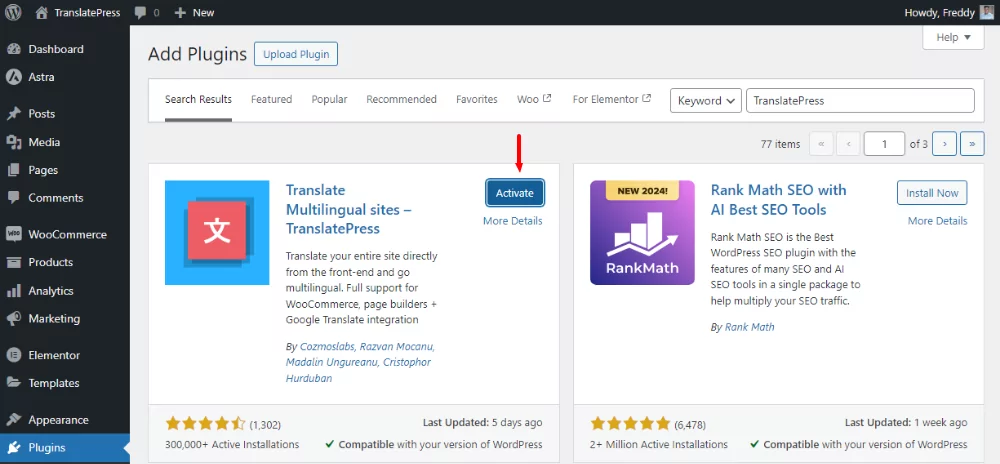
Once you have activated the plugin, it is time to set up some default settings. We will begin by setting the default language i.e., English, and the translation language i.e., Arabic.
To do so, navigate to Settings → TranslatePress, as shown below.
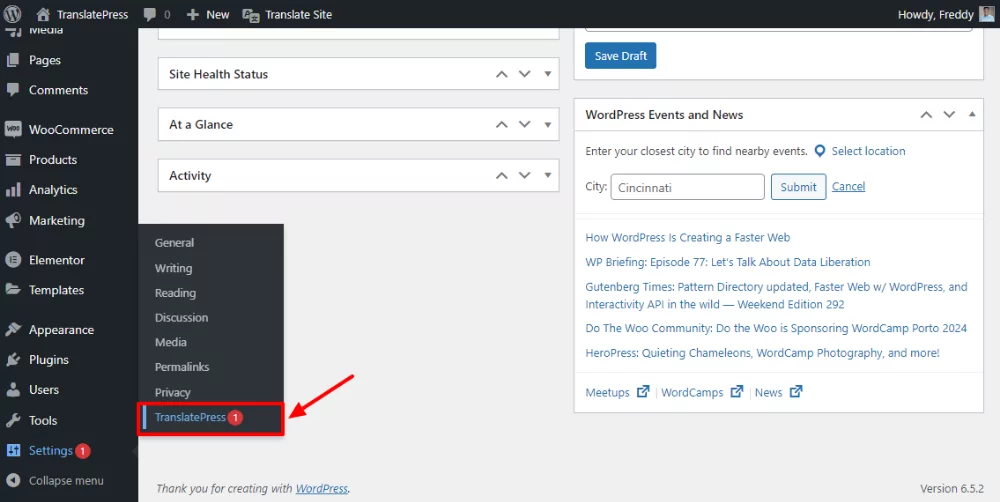
Under the General tab, set the default language (mine is English (United States)), and then choose Arabic in the All Languages section. Next click Add and Save Changes, as demonstrated below.
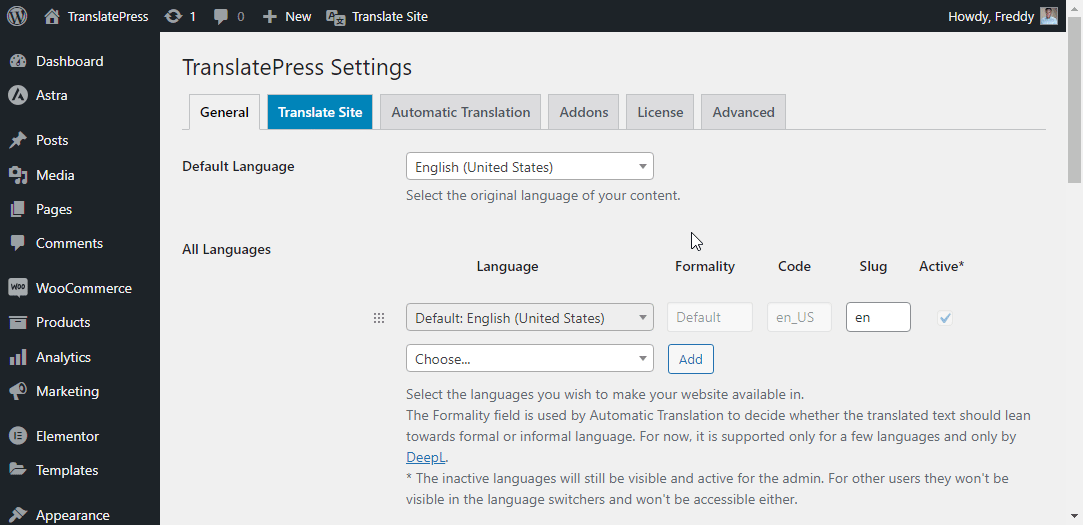
As usual, always remember to save your changes.
Pro Tip: TranslatePress Personal and other paid plans let you add multiple translation languages and dialects such as Moroccan Arabic. You also have many more features, as you will learn later.
Don’t be in a hurry to check your site yet. At the moment, we have just installed TranslatePress and added our preferred languages. Now you let us translate the website to Arabic either automatically or manually.
How to Translate a Site to Arabic Automatically
In this section, I will show you how to translate a site to Arabic using TranslatePress. The plugin supports automatic translations via Google Translate and DeepL.
I am using DeepL since it has better support for automatic Arabic translations than Google Translate. Note that to use DeepL, you must upgrade to the TranslatePress Business Plan.
While you can translate a site to Arabic manually, or hire a professional translation service, automatic translation saves time and cuts costs.
The best part is you can translate a site to Arabic for free provided you don’t exceed the limits of the DeepL free tier.
DeepL allows you to translate 500k characters per month for free. That is about 100k words per month. Once you exceed the limits of the free tier, you’ll pay a flat $5.49 per month plus $25 per one million characters that you translate
The good thing with TranslatePress is you only need to pay DeepL usage fees once since TranslatePress stores translations in your database. You don’t need to translate the content on every page visit.
Let’s get down to business.
First, you need to generate a DeepL API key. To do that, follow the linked guide or watch the video below.
Once you generate your DeepL API key, head back to TranslatePress settings, and click the Automatic Translation tab, as shown below.
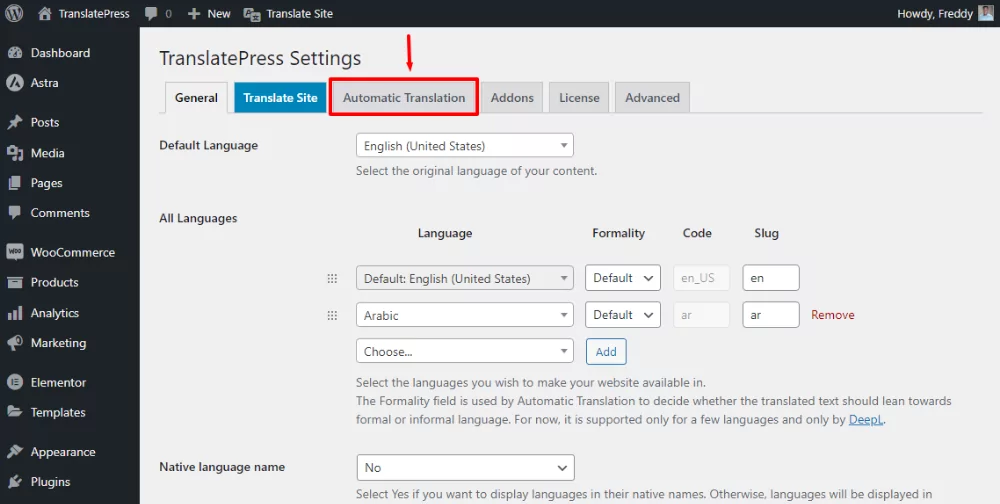
After that, enable automatic translation, copy-paste your DeepL API key, and save your changes, as highlighted below.
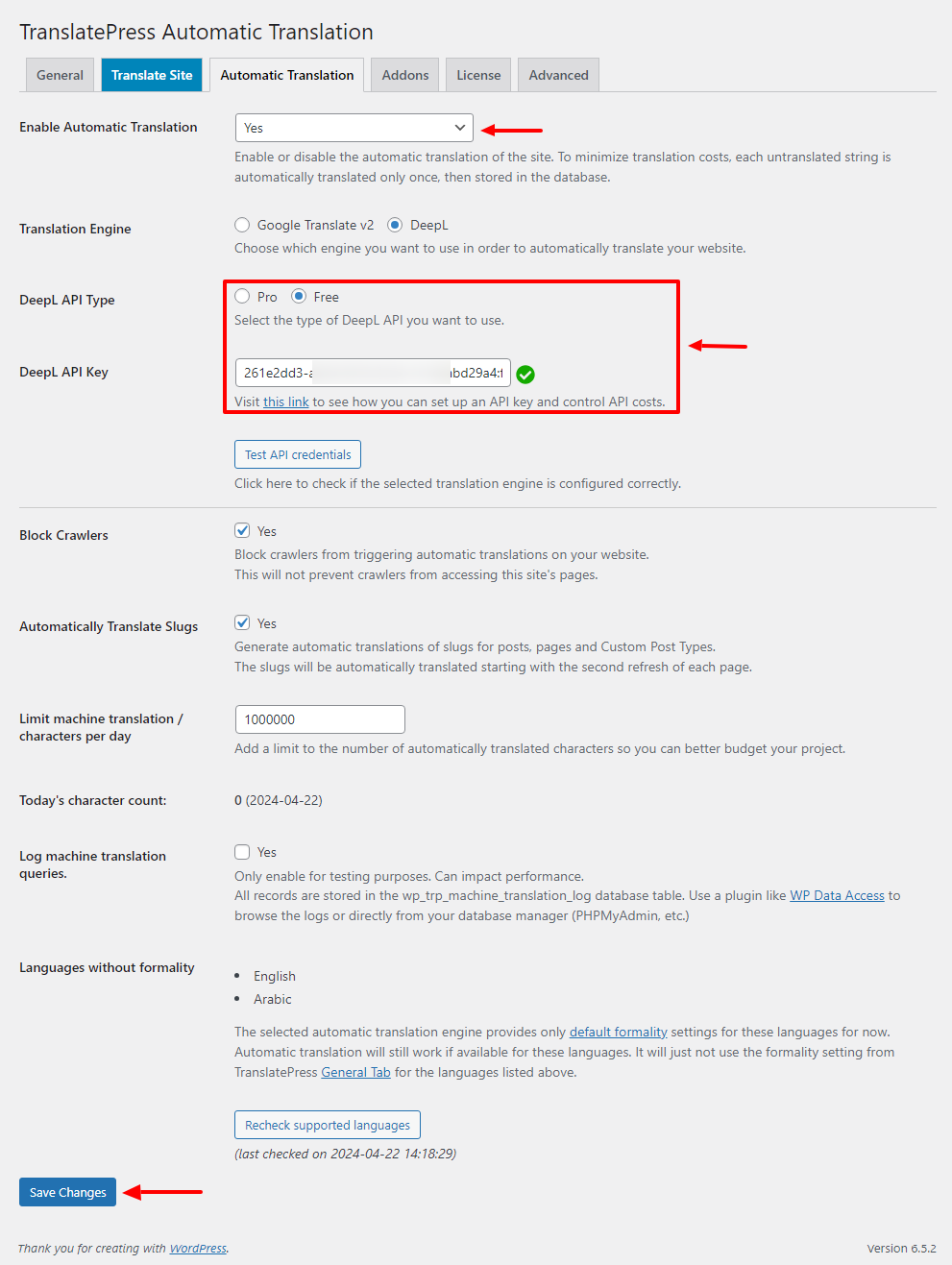
And that’s all there is to do. TranslatePress will take over from there and translate your site to Arabic in the background.
Now, if you use the language switcher in the front end, you will see the Arabic version of your site.

That was as simple as A, B, C. Now wasn’t it?
At this point, you have successfully translated your site to Arabic automatically. But as you’d expect, a machine cannot capture all the nuances of human language, especially Arabic.
For instance, DeepL might miss slang and other phrases common in English but lack equivalents in Arabic. Also, you might not like how DeepL translates some words.
Here’s where manual translation comes in to save the day.
How to Translate a Site to Arabic Manually Using TranslatePress
This is where the TranslatePress WordPress translation plugin wins the day. After enabling automatic translations, you can edit translated text manually to polish everything.
TranslatePress ships with a visual translation editor that allows you to edit translations on the front end like a boss.
Open the page you’d like to translate and click Translate Page on the WordPress admin bar, as shown below.
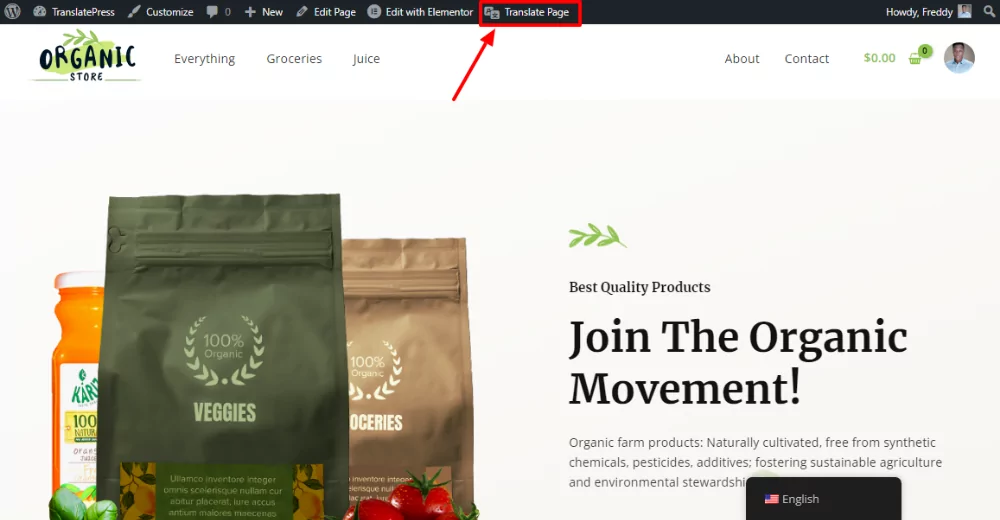
After that, set the language to Arabic so you can see the translation changes directly on the page.
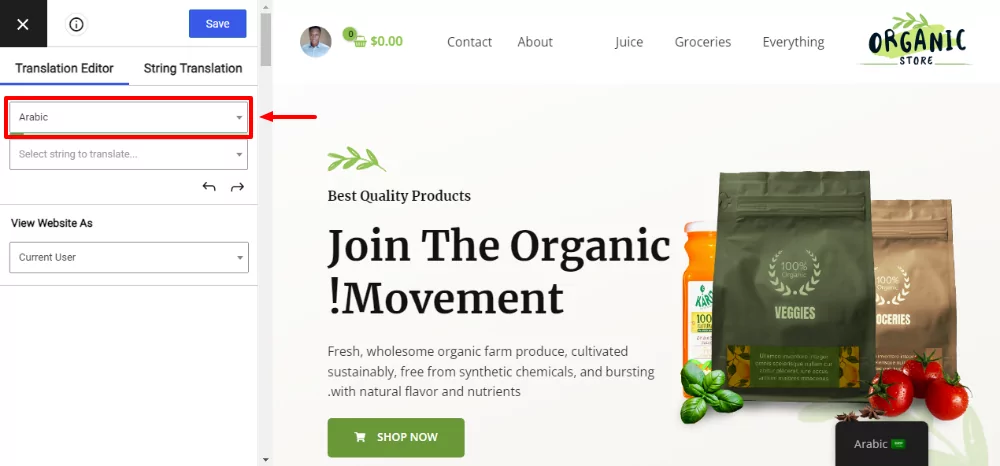
After that, select the text you want to translate by clicking the pencil icon. Enter the Arabic translation and click the Save button, as shown below.
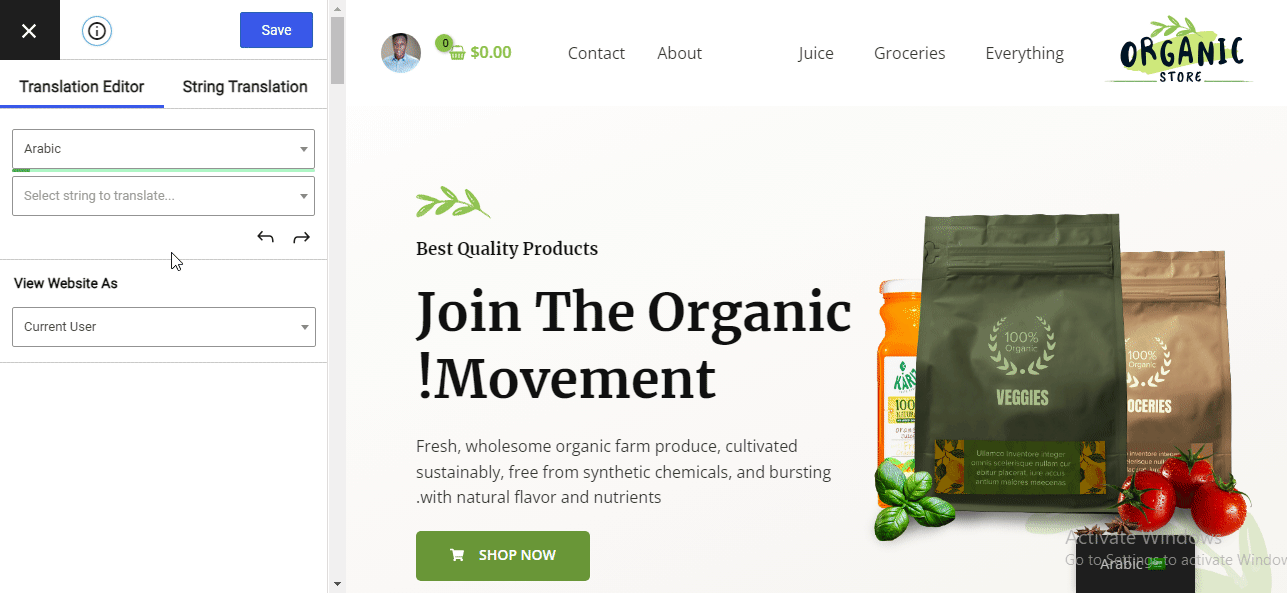
As you can see, manually translating a site to Arabic using TranslatePress is as easy as pie. You can translate all content on your site similarly. This includes:
- Navigation menus;
- Images, sliders, and videos;
- WooCommerce emails;
- Dynamic stings from themes and plugins;
- SEO elements and URLs.
Also, check out:
- How to Translate a WordPress Plugin in Any Language;
- How to Translate a WordPress Theme – Full Theme Translation Guide.
Note some of these features, such as translating SEO elements, are only available in the paid versions of TranslatePress.
Other Notable TranslatePress Pro Features
While the free version of TranslatePress offers you what you need to translate a site to Arabic, the pro version has advanced features to control your translations fully.
Other TranslatePress Pro features include:
- Full Yoast SEO support;
- Support for 221 extra languages;
- Translate SEO title, descriptions, and slug;
- Publish only when translation is complete;
- Translate by Browsing as User Role;
- Different Menu Items for each Language;
- Automatic User Language Detection;
- Et cetera.
You can use the same process to translate a website from any language (not just English) to Arabic and vice versa.
TranslatePress Multilingual
Now you know how to translate a site to Arabic quickly and accurately. As you have seen, it is easy, especially with a tool such as TranslatePress.
What are your views? Please let us know in the comment section. If you found the post useful, please consider sharing it to help others!

